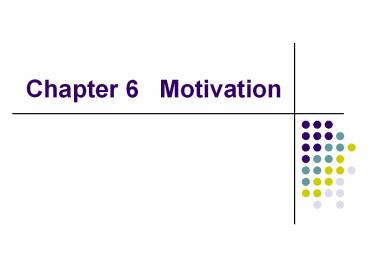Chapter 6 Motivation - PowerPoint PPT Presentation
1 / 24
Title: Chapter 6 Motivation
1
Chapter 6 Motivation
2
- 1.outline the basic motivation process
- 2.describe Maslows hierarchy of need theory
- 3.contrast theory X and theory Y
- 4.differentiate motivators from hygiene factors
- 5.list the characteristics that high achievers
prefer in a job - 6.contrast reinforcement and goal-setting
theories - 7.explain equity theory
- 8.clarify the key relationships in expectancy
theory
3
1 what is motivation?
- Unsatisfied Tension Drives
Search - need
behavior - Satisfied Reduction
- need of tension
- Basic Motivation Process
tension
4
2 Early theories of motivation
- 2.1 Hierarchy of needs theory
-
higher-order - self-actualization
internally - esteem
- social
- safety
lower-order -
physiological externally - Maslows hierarchy of need
theory - (????????)
5
- Alderfers ERG theory
- Existence (safety physiological)
- Relatedness (social)
- Growth (esteem self-actualization)
6
- 2.2 theory X and theory Y
- Douglas McGregor
- Two distinct views of human beings
- basically negativetheory X
- basically positivetheory Y
7
- 2.3 two-factor theory(?????)
- motivation-hygiene theory
- Question
- What do people want from their job?
- He asked people to describe, in detail, situation
in which they felt exceptionally good or bad
about their jobs.
8
- Hygiene factors affect Motivator
factor affect - job dissatisfaction job
satisfaction - Quality of supervision Promotional
opportunities - Pay
Opportunities for personal -
growth - Company policies Recognition
- Physical working conditions Responsibility
- Relations with others Achievement
- Job security
- high job dissatisfaction 0
job satisfaction high
9
- Satisfaction Dissatisfaction
- Satisfaction No Satisfaction
- Dissatisfaction No Dissatisfaction
10
- The factors leading to job satisfaction are
separate and distinct from those that lead to job
dissatisfaction. - Managers who seek to eliminate factors that can
create job dissatisfaction may bring about peace
but not necessarily motivation. - Hygiene factors when theyre adequate, people
will not be dissatisfied neither will they be
satisfied. - Motivation factors satisfied,
- intrinsically
rewarding
11
- Criticisms
12
3 contemporary theories of motivation
- 3.1 McClellands theory of needs
- Three major relevant motives or needs in the
workplace - Need for achievement (nAch)
- Need for power (nPow)
- Need for affiliation (nAff)
13
- First, individuals with a high nAch prefer job
situation with personal responsibility, feedback,
and an intermediate degree or risk. - Second, a high nAch does not necessarily lead to
being a good manager, especially in large
organizations. - Third, the best managers are high nPow and low
nAff. - Last, employees have been successfully trained to
stimulate their achievement need.
14
- 3.2 Goal-Setting theory(??????)
- Intentions (goals) can be a major source of work
motivation. - Specific goals increased performance
- Difficult goals higher performance?
- The specificity of the goal itself acts as an
internal stimulus.
15
- If employee have the opportunity to participate
in the setting of their own goals, will they try
harder? - A major advantage of advantage of participation
may be in increasing acceptance of the goal
itself as a desirable one to work toward.
16
- 3.3 Reinforcement theory(????)
- A behavioristic approach
- reinforcement conditions behavior
- What controls behavior are reinforce any
consequences that ,when immediately following a
response, increase the probability that the
behavior will be repeated.
17
- People will exert more effort on tasks that are
reinforced than on tasks that are not?
18
- 3.4 Equity theory(????)
- Center---- relative reward
- There is ample evidence for us to conclude that
employees compare their own job inputs and
outcomes with those of others and that inequities
can influence the degree of effort that employee
exert.
19
- Equity theory says that employee weigh what they
put into a job situation (input) against what
they get from it (outcome) and then compare their
inputout come ratio with the input outcome
ratio of relevant others. - If the ratios are unequal, inequity exist that
is, the employees tend to view themselves as
underrewarded or overrewarded.
20
- When inequities occur, employee will attempt to
correct them.
21
- Three referent categories
- other system self
- Other other individuals
- System pay policies and procedures
- administration
- Self input outcome ratios
22
- Five choices
- Four propositions relating to inequitable pay
23
- 3.5 Expectancy theory(????)
- Victor Vroom
- Expectancy theory argues that the strength of a
tendency to act in a certain way depends on the
strength of an expectation that the act will he
followed by a given outcome and on the
attractiveness of that outcome to the individual.
24
- Three variables
- Attractiveness
- Performance / reward linkage
- Effort/ performance linkage
- 1 2
3
Individual effort
Individual performance
Organizational rewards
Individual goals































